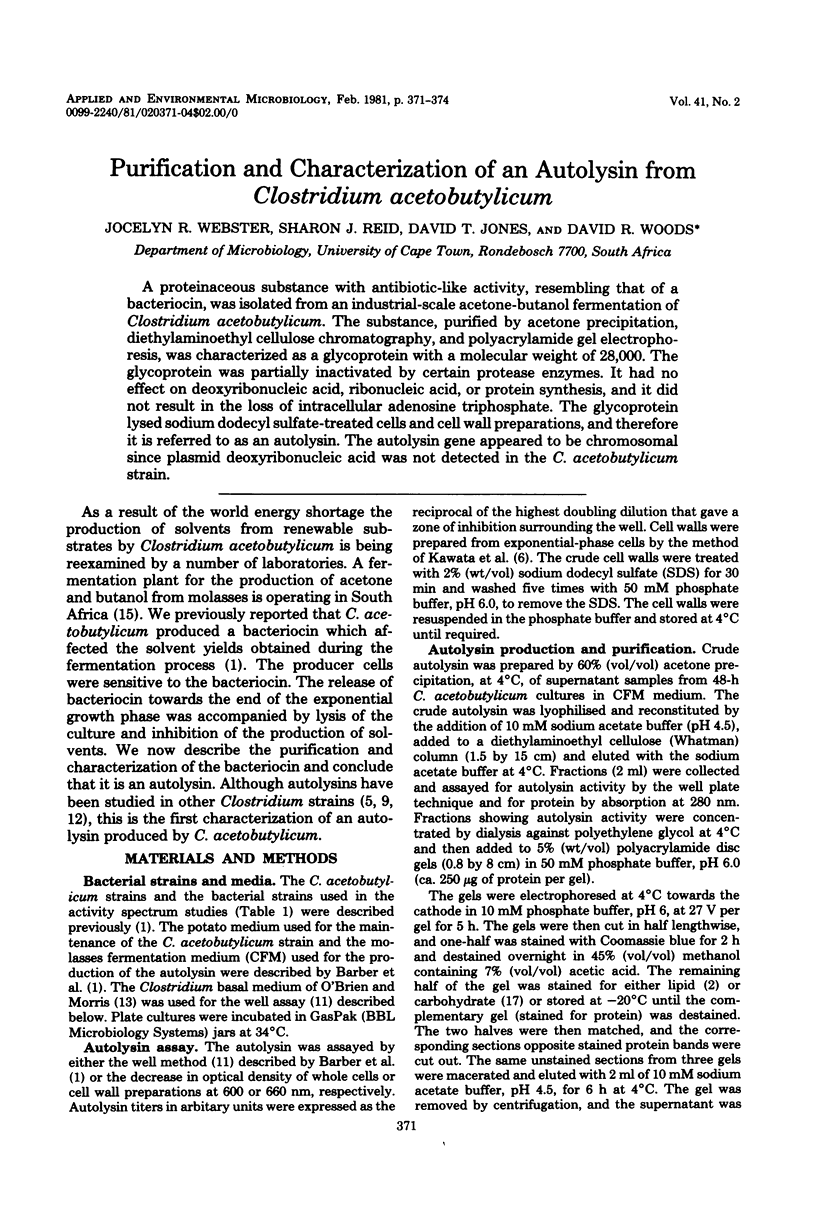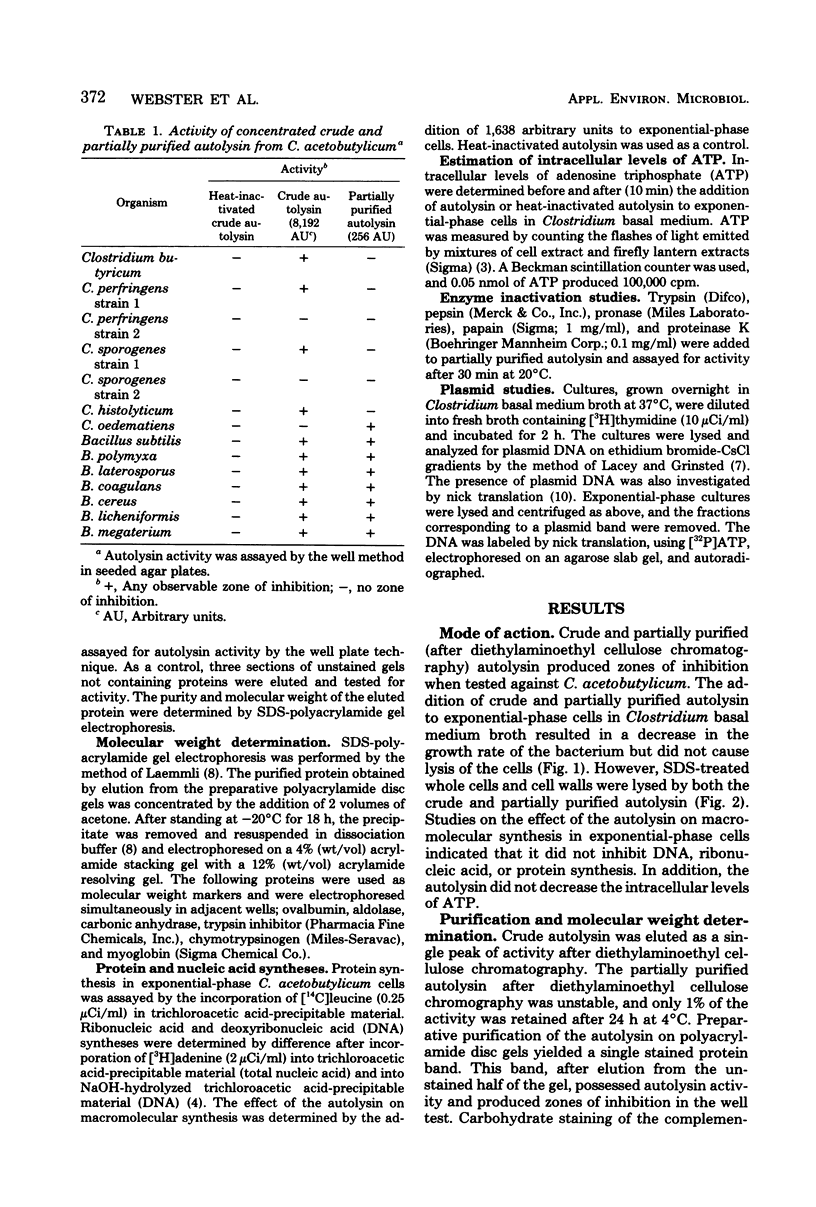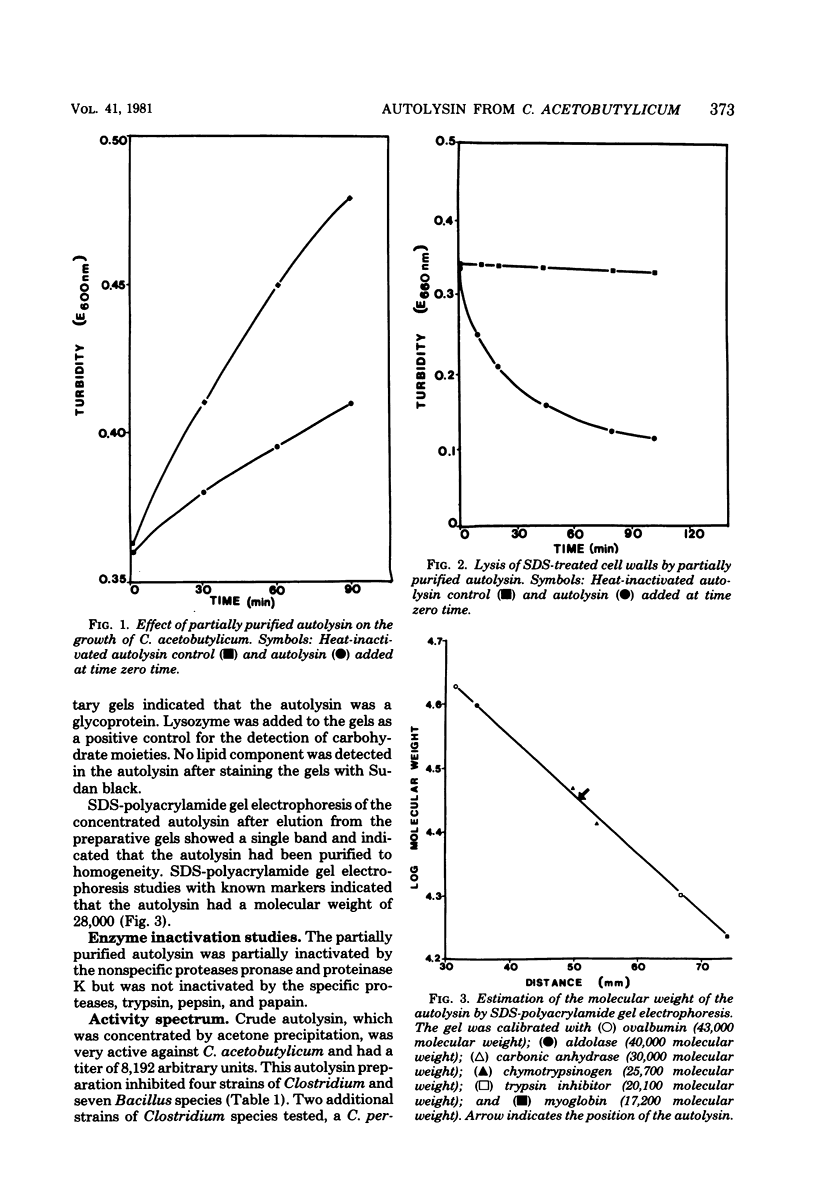Abstract
A proteinaceous substance with antibiotic-like activity, resembling that of a bacteriocin, was isolated from an industrial-scale acetone-butanol fermentation of Clostridium acetobutylicum. The substance, purified by acetone precipitation, diethylaminoethyl cellulose chromatography, and polyacrylamide gel electrophoresis, was characterized as a glycoprotein with a molecular weight of 28,000. The glycoprotein was partially inactivated by certain protease enzymes. It had no effect on deoxyribonucleic acid, ribonucleic acid, or protein synthesis, and it did not result in the loss of intracellular adenosine triphosphate. The glycoprotein lysed sodium dodecyl sulfate-treated cells and cell wall preparations, and therefore it is referred to as an autolysin. The autolysin gene appeared to be chromosomal since plasmid deoxyribonucleic acid was not detected in the C. acetobutylicum strain.
Full text
PDF



Selected References
These references are in PubMed. This may not be the complete list of references from this article.
- Barber J. M., Robb F. T., Webster J. R., Woods D. R. Bacteriocin production by Clostridium acetobutylicum in an industrial fermentation process. Appl Environ Microbiol. 1979 Mar;37(3):433–437. doi: 10.1128/aem.37.3.433-437.1979. [DOI] [PMC free article] [PubMed] [Google Scholar]
- Foulds J. Mode of action of a bacteriocin from Serratia marcescens. J Bacteriol. 1971 Sep;107(3):833–839. doi: 10.1128/jb.107.3.833-839.1971. [DOI] [PMC free article] [PubMed] [Google Scholar]
- Kawata T., Takumi K. Autolytic enzyme system of Clostridium botulinum. I. Partial purification and characterization of an autolysin of Clostridium botulinum type A. Jpn J Microbiol. 1971 Jan;15(1):1–10. [PubMed] [Google Scholar]
- Kawata T., Takumi K., Sato S., Yamashita H. Autolytic formation of spheroplasts and autolysis of cell walls in Clostridium botulinum type A. Jpn J Microbiol. 1968 Dec;12(4):445–455. doi: 10.1111/j.1348-0421.1968.tb00418.x. [DOI] [PubMed] [Google Scholar]
- Lacey R. W., Grinsted J. Linkage of fusidic acid resistance to the penicillinase plasmid in Staphylococcus aureus. J Gen Microbiol. 1972 Dec;73(3):501–508. doi: 10.1099/00221287-73-3-501. [DOI] [PubMed] [Google Scholar]
- Laemmli U. K. Cleavage of structural proteins during the assembly of the head of bacteriophage T4. Nature. 1970 Aug 15;227(5259):680–685. doi: 10.1038/227680a0. [DOI] [PubMed] [Google Scholar]
- Mahony D. E., Butler M. E., Lewis R. G. Bacteriocins of Clostridium perfringens. 2. Studies on mode of action. Can J Microbiol. 1971 Nov;17(11):1435–1442. doi: 10.1139/m71-228. [DOI] [PubMed] [Google Scholar]
- Maniatis T., Jeffrey A., Kleid D. G. Nucleotide sequence of the rightward operator of phage lambda. Proc Natl Acad Sci U S A. 1975 Mar;72(3):1184–1188. doi: 10.1073/pnas.72.3.1184. [DOI] [PMC free article] [PubMed] [Google Scholar]
- Nakamura S., Okada I., Mizuno J., Nishida S. Clostridium perfringens--specific lysin. Can J Microbiol. 1977 May;23(5):601–606. doi: 10.1139/m77-087. [DOI] [PubMed] [Google Scholar]
- O'Brien R. W., Morris J. G. Oxygen and the growth and metabolism of Clostridium acetobutylicum. J Gen Microbiol. 1971 Nov;68(3):307–318. doi: 10.1099/00221287-68-3-307. [DOI] [PubMed] [Google Scholar]
- Tagg J. R., Dajani A. S., Wannamaker L. W. Bacteriocins of gram-positive bacteria. Bacteriol Rev. 1976 Sep;40(3):722–756. doi: 10.1128/br.40.3.722-756.1976. [DOI] [PMC free article] [PubMed] [Google Scholar]
- Upreti G. C., Hinsdill R. D. Isolation and characterization of a bacteriocin from a homofermentative Lactobacillus. Antimicrob Agents Chemother. 1973 Oct;4(4):487–494. doi: 10.1128/aac.4.4.487. [DOI] [PMC free article] [PubMed] [Google Scholar]


